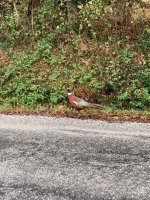I live in SW MO. About 30 miles south of Springfield. Buddy brushhogging on my land sent me this today. Kind of odd I thought, as I don't know of any preserves that are relatively close to my place. I walked out to look at this one and couldn't get a good look as it was pretty skittish and fast.
He did tell me he saw a rooster while mowing someone else's place not too far from mine, but who knows.
We did leave some cover for this lady to hide in, but with coyotoes around here, I don't imagine she will last long. Pretty neat and I thought I would share. Would be nice to imagine it's a wild bird, but I'm guessing highly unlikely. I will get the dog out tomorrow and see if she is still around.
On a side note, I did have a couple of nice coveys on my land when I bought it a couple of years ago, but I haven't seen them since moving onto it.
He did tell me he saw a rooster while mowing someone else's place not too far from mine, but who knows.
We did leave some cover for this lady to hide in, but with coyotoes around here, I don't imagine she will last long. Pretty neat and I thought I would share. Would be nice to imagine it's a wild bird, but I'm guessing highly unlikely. I will get the dog out tomorrow and see if she is still around.
On a side note, I did have a couple of nice coveys on my land when I bought it a couple of years ago, but I haven't seen them since moving onto it.


